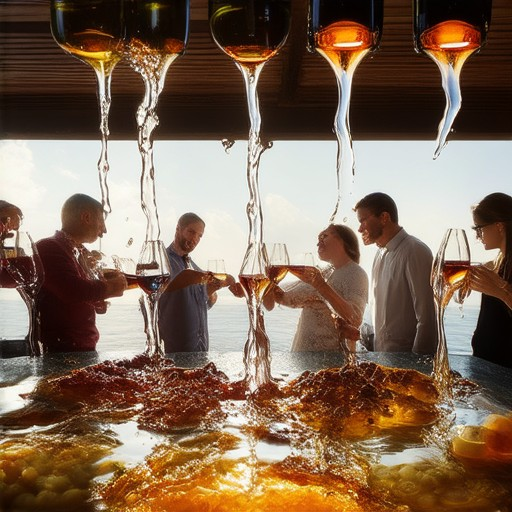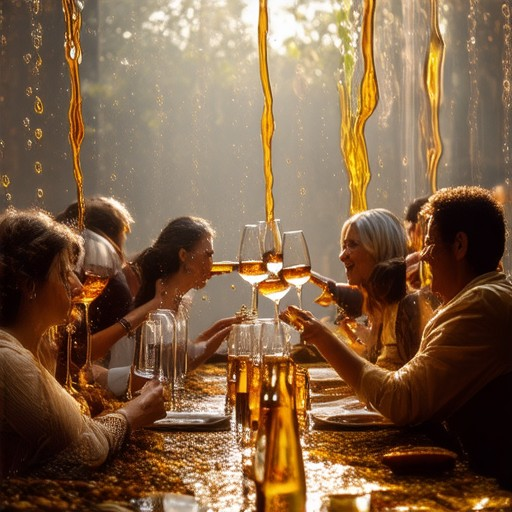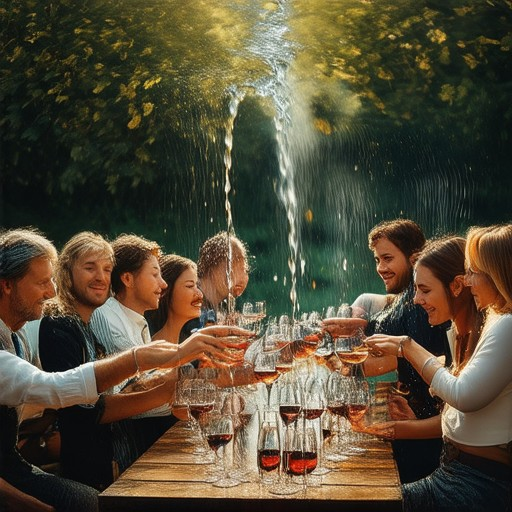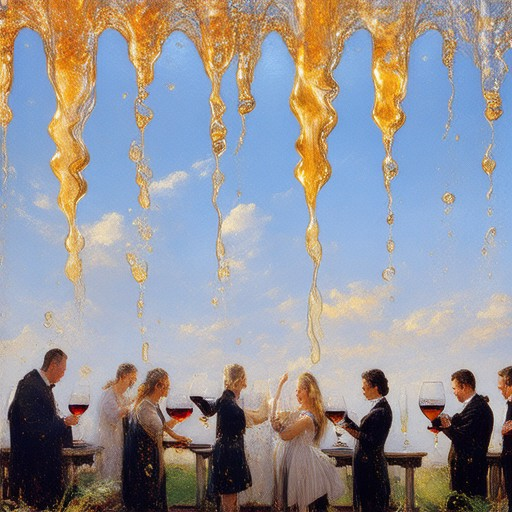Planning a special anniversary celebration? Why not elevate your event with a wine tasting experience? Whether you’re a seasoned wine enthusiast or new to the world of wine, organizing a wine tasting for anniversaries can be both memorable and stress-free. From budget considerations to food pairings and hosting tips, this guide offers everything you need to create a perfect blend of sophistication and enjoyment. Discover how to choose the right wines, set up an inviting atmosphere, and make your anniversary one to remember. With expert tips and insights, you’ll learn how to host a successful wine tasting event that brings your loved ones together in a celebration of taste and tradition.
Key Takeaways
- Set the Mood: Create a cozy, dimly lit atmosphere with soft music and candlelit tables to enhance the ambiance.
- Diverse Wine Selection: Offer a variety of wines, including reds, whites, sparklings, and dessert wines, to cater to different palates.
- Interactive Activities: Engage guests with blind tastings, wine aroma games, and charcuterie bars for added fun and interaction.
- Food Pairings: Complement wines with cheeses, cured meats, and chocolates to elevate the tasting experience.
- Competition Elements: Add excitement with games like wine tossing and guessing contests.
- DIY Charcuterie Bar: Provide a social hub for guests to explore flavor combinations.
- Auction Option: Excite attendees with a live or silent auction featuring rare wines.
- Educational Sessions: Informative tastings help guests appreciate wine nuances.
- Cost-Effective Hosting: Theme-based parties and DIY elements reduce expenses while maximizing impact.
- Balanced Pairing: Match wines thoughtfully with foods to ensure a harmonious experience.

How Much Do Wine Tasting Events Cost?
The cost of wine tasting events varies significantly based on location, the type of event, and the number of wines tasted. Here’s a breakdown of typical pricing:
- Average Costs :
- Basic Tastings : Typically range from $20 to $50 per person.
- Premium Tastings : Often priced between $40 and $80, offering more exclusive or larger pours.
- Luxury Events : High-end events can exceed $100 per person, featuring rare wines or VIP experiences.
- Factors Influencing Pricing :
- Location : Urban areas or popular wine regions may charge higher fees.
- Number of Wines Tasted : More wines often mean a higher cost.
- Inclusions : Whether the event includes food pairings, live entertainment, or other amenities can affect the price.
- Additional Considerations :
- Some events may charge per person, while group discounts are sometimes available.
- Premium packages or memberships can provide extended access to exclusive wines.
For more detailed information and recommendations, visit our wine tasting cost guide .
The 5 S’s of Wine Tasting
- Sniff – Take a moment to inhale the aroma of the wine. This step is crucial as it allows you to detect the wine’s bouquet and nose, giving insight into its quality and character.
- Swirl – Once you’ve sniffed, swirl the wine in your glass. This motion aerates the wine, releasing trapped aromas and allowing them to develop further.
- Sip – After swirling, take a slow sip to taste the wine. Pay attention to its flavor profile, including notes of sweetness, acidity, and tannins.
- Spit – If you prefer not to consume the entire sample or wish to save space, spit the wine after sipping. This is a common practice during professional tastings.
- Slurp – Finally, if you choose to drink the wine quickly, you can “slurp” it through your nose. This technique is often associated with certain cultural practices and helps in clearing the palate between tastings.

Best Month for Wine Tasting
The optimal month for wine tasting depends on several factors, including weather conditions, harvest timing, and event availability. Here’s a breakdown of the best times to visit based on regional considerations:
California Wine Country
- Peak Season : Summer through early fall (June to October) is ideal for exploring California’s wine regions. The weather is warm and dry, making it perfect for outdoor tastings and vineyard tours.
- Harvest Season : Late summer to early winter (September to November) is particularly special as it coincides with grape harvesting. Many wineries host events during this time, offering unique tasting experiences.
Best Time to Visit Specific Regions
- Northern California (Napa Valley) : The best time to visit is during the fall months (September to November) when the weather is mild, and harvest festivals are taking place.
- Southern California (Santa Barbara, Paso Robles) : These regions offer year-round wine tasting opportunities, with spring and fall being particularly pleasant due to milder temperatures.
Top Wine Tasting Events
- Sonoma Harvest Fair : Held in late September, this festival offers a chance to sample wines from local producers while enjoying live music and food pairings.
- Mendocino Wine Country Days : Taking place in May, this event showcases the region’s diverse wines and scenic beauty.
Practical Tips
- Plan Ahead : Book accommodations and tasting appointments early, especially during peak seasons.
- Explore Local Wineries : Use resources like Fine Vines to discover recommended wineries and tasting rooms.
For a more immersive experience, consider visiting during harvest season or attending seasonal wine events. Whether you’re a casual taster or a serious enthusiast, the right month can elevate your wine-tasting adventure.

How to Make Wine Tasting Fun for Adults
Transforming a wine tasting event into an engaging and enjoyable experience for adults requires thoughtful planning and creative activities. Here’s a guide to making your wine tasting fun and memorable:
1. Create the Right Atmosphere
- Set the Mood: Opt for a cozy, dimly lit room with soft music playing in the background. Candlelit tables or a crackling fireplace can enhance the ambiance.
- Comfortable Seating: Arrange comfortable chairs or bean bags to encourage relaxation and interaction among guests.
2. Select the Perfect Wine Selection
- Offer a Variety: Include a diverse range of wines, such as reds, whites, sparklings, and dessert wines, to cater to different palates.
- Provide Tasting Cards: Offer descriptive cards for each wine, including clues like grape variety, region, and flavor notes to spark conversation.
3. Add Interactive Elements
- Blind Tasting Games: Organize blind tasting exercises where guests guess the wine’s origin, grape type, or age. This adds an element of surprise and competition.
- Wine Pairing Activities: Set up a wine and food pairing station with artisan cheeses, cured meats, and chocolates to enhance sensory experiences.
4. Incorporate Fun Activities
- Wine Trivia: Create a quickfire round of wine-related questions to test knowledge and spark discussions.
- Wine Aroma Games: Have guests identify wine aromas before tasting to add an extra layer of engagement.
- Charcuterie and Wine Pairing: Offer a DIY charcuterie bar with accompaniments to pair with selected wines, encouraging social interaction.
5. Add a Touch of Competition
- Wine Toss Game: Set up targets and have guests toss wine corks at them for a fun and playful activity.
- Wine Guessing Contest: Blindfold guests and have them guess the wine based on appearance, aroma, and taste.
6. End with a bang!
- Auction Off: Host a live or silent auction featuring rare or premium wines to excite attendees and raise funds for a cause.
- Final Toast: Conclude the event with a heartfelt toast, thanking everyone for their participation and enjoyment.
By combining these elements, you’ll create a wine tasting experience that’s not only educational but also fun and memorable for all adults involved. Cheers to a successful and enjoyable event!
How to Host a Simple Wine Tasting
To host a simple wine tasting event at home, follow these organized steps for a seamless and enjoyable experience:
- Plan and Prepare in Advance
- Select a date and time convenient for you and your guests.
- Decide on the number of wines you wish to showcase, typically 3-5 varieties.
- Research and prepare a diverse selection, including reds, whites, and maybe a sparkling wine.
- Create a tasting schedule, possibly including a welcome wine and a dessert wine.
- Set Up Your Space
- Choose a location with good lighting and a table for presenting wines.
- Provide wine glasses, water bottles, and napkins for each guest.
- Arrange snacks or small appetizers to complement the wines.
- Select the Wines
- Opt for wines from different regions and grape varieties to offer variety.
- Consider the flavor profiles and pairings to enhance the tasting experience.
- Use a wine decanter or pour directly from the bottle into glasses.
- Create a Tasting Menu
- Include a variety of wines, such as a Sauvignon Blanc, a Pinot Noir, and a Cabernet Sauvignon.
- Pair each wine with complementary foods like cheese, charcuterie, or dark chocolate.
- Offer a white wine and a sparkling wine for a refreshing contrast.
- Guide Your Guests Through the Tasting
- Introduce each wine with its origin, grape variety, and tasting notes.
- Encourage guests to swirl, sniff, and taste the wine, noting their impressions.
- Discuss how the wine pairs with food and share personal preferences.
- Clean Up After the Tasting
- Collect empty glasses and dispose of waste promptly.
- Thank your guests for attending and provide feedback if possible.
For more detailed wine tasting tips and resources, visit Fine Vines .

Food Pairings for Wine Tasting Parties
When hosting a wine tasting party, selecting the right food pairings can elevate the experience. Here are some excellent food options that complement wine flavors:
- Cheeses : Cheddar, Brie, Gouda, and Blue Cheese are excellent choices. They pair well with red wines and provide a rich, creamy contrast.
- Snacks : Baguette, Crostini, and Charcuterie Platters. These options are versatile and allow guests to explore different flavor profiles with their wines.
- Appetizers : Antipasto Skewers with marinated vegetables and olives, and cured meats like Prosciutto or Salami. These dishes offer bold flavors that complement red wines.
- Main Courses : Grilled Fish or Chicken with seasonal ingredients. These lighter dishes allow guests to enjoy the meal without overwhelming their palates.
- Desserts : Dark Chocolate and caramelized fruits like apples or pears with honey. These options provide a sweet finish that pairs well with select red wines.
- Beverages : Offer sparkling water or herbal tea to cleanse the palate between wine tastings. This helps enhance the flavor perception of each wine.
By offering a variety of these foods, you can create a balanced and engaging tasting experience. Remember to keep portions small and diverse to allow guests to explore different flavor combinations with their chosen wines.



0 Comments